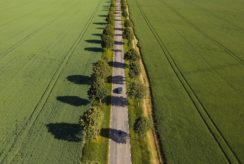In Paris, on May 16-18, the third edition of the Viva Technology conference was held. Viva Technology is the world’s rendezvous for startups and leaders to celebrate innovation.
At this year’s edition, energy transition was one of key issues, with the E-Tree setting the stage as soon as visitors entered the venue. Representing a powerful symbol, the E-tree is a smart, solar-powered tree that offers multiple services, including wi-fi, a smart screen, public lighting, phone charging facilities, etc.
Rethinking urban logistics: one of the challenges of Groupe La Poste for building sustainable, smart cities

Philippe Wahl
CEO of Le Groupe La Poste
Our mail men and women use some 9,000 electric vehicles throughout all of France.
The energy transition is underway via a number of initiatives, most significantly the Smart City. Today, the challenge faced by large metropolitan areas is to sustainably urbanize tomorrow’s cities. In his conference, CEO Philippe Wahl highlighted the commitment of Groupe La Poste towards developing smart and sustainable cities. Among the transformations with which the French mail delivery giant must now contend, e-commerce is without doubt one of the most profound. Faced with the boom in online sales, the CEO affirmed that “e-commerce is not only transforming our lives, but also urban life at large.” Given the urgency of the energy transition, pollution in towns and cities, and road congestion problems, Groupe La Poste has opted to co-develop ecological, low-carbon distribution via electric vehicles and bikes with major cities and communities. “Our mail men and women now use some 9,000 electric vehicles throughout all of France”, states Philippe Wahl. This model is set to be generalized: the Group has already signed agreements with 18 French cities to implement alternative solutions tailored to each one’s requirements.
Electric vehicle recharging points, an opportunity for sustainable territories
A key player in carbon-free mobility, ENGIE was present at the Mobility Park, where this leading energy player showcased its innovations in carbon-free mobility. ENGIE presented actions on clean mobility systems, tested or deployed.
In fact, electric mobility was omnipresent at this year’s event, and the ENGIE stand was no exception. A speaker from ENGIE Réseaux, a subsidiary of ENGIE Energie Services, presented the network of recharging terminals which is very much akin to ENGIE’s core-business district heating network. Large-scale projects have already been deployed, such as the operation of 4,000 electric vehicle charging points in Rotterdam, the Netherlands’ second-biggest city.
Two levers can be implemented for this purpose: firstly, in the short term, ENGIE is trying out curtailment; in case of any mismatch between the supply and demand for electricity, the energy dedicated to charging vehicles can be reduced. Secondly, ENGIE is looking into the Car to Grid concept, where the electricity stored by vehicles can be returned to the grid in the event of consumption spikes, and vice versa.
SMATCH, ENGIE's intelligent recharging solution
One of the green mobility solutions developed by ENGIE is SMATCH innovation, to intelligently manage electric charging. Via this product, ENGIE reconciles the load control requirements of vehicle drivers with those of site managers. Power peaks are reduced by spreading them out in line with demand via a communication software solution, which displays the battery’s recharging in real time. SMATCH is thus intended to relieve electric vehicle users’ anxiety concerning the efficiency of their vehicle charge. Using data provided by the user beforehand, the vehicle’s recharge is optimized and scaled suitably.
Set up in Belgium in 2015, SMATCH can lead to significant installation cost savings, thereby furthering the deployment of electric vehicles and, more generally, the energy transition.
With the energy transition now clearly under way, the various issues addressed reflect the growing concerns of the different players regarding the sector’s upheavals. Solutions and innovations are on the rise across the entire energy value chain. To underpin this transition, the transformations engaged must go even further: devising smart cities with low-carbon mobility services, integrating electrical storage in the use of renewable energies, and adopting new technologies to reduce energy consumption.
Robotic innovations at EDF's Robot Park
In this year’s edition of the Viva Technology event, EDF was present at its Discovery by EDF space, in which it showcased the innovations of more than 40 startups. In the space’s central arena, EDF placed these avant-garde startups under the spotlight.
The energy company also sponsored the Robot Park, dedicated entirely to the latest robotic innovations. The space featured eight robots at the cutting edge of innovation in advanced fields. One of these innovations was the Da Vinci robotic surgical system developed by Intuitive Surgical, designed to facilitate complex surgery using a minimally invasive approach. This is achieved by providing surgeons with enhanced visualization, greater precision and ergonomic comfort.
Another innovation, this time in the field of agriculture, was Vitirover‘s autonomous, remote controlled mower robot. Designed to replace the use of glyphosate, the robot can mow very large areas, and is powered by a solar panel installed on its upper surface.
Total involved in developing projects in Africa
African Tech was very much at the forefront of the Africatech space, dedicated to innovative African startups and players. A series of conferences was organized with a host of personalities to discuss the potential for innovation in Africa.
These talks emphasized the challenges facing the African continent, with the energy transition high up on the list. Engaged in this respect, Total presented its solutions to guarantee better access to energy in Africa. Through its Total Access to Energy program, the group is developing projects in cooperation with a network of startups to promote local initiatives. Access to energy involves developing micro-grids, i.e. electricity production and distribution networks intended for a small number of consumers. A range of services and solar products has also been developed for populations without access to electricity. In fact, a solar kits offer has already been deployed, with micro-payment possibilities that are becoming increasingly democratized. The goal is to ensure sustainable access to energy for the most vulnerable communities.
Focus on some startups and innovations
ECO WAVE POWER is Europe’s first company to supply the electricity grid with power converted entirely from wave energy. This startup develops wage energy power stations that run using floating converters. The first station was inaugurated in Gibraltar in June 2016. In her pitch at Viva Technology, the founder proudly announced that 15% of Gibraltar’s energy now comes from waves. A promising future!
Operating at the crossroads between smart energy and energy storage, the Otonohm startup offers a technological breakthrough in the shape of the BMS (Battery Management System). For the past three years, the startup has been designing and developing batteries that are lighter, less bulky, and with no unnecessary power loss. The goal is to move on from single-use batteries to multi-purpose batteries with 98% available energy.
.
In response to today’s environmental challenges, WoodLight offers a revolutionary lighting system. The startup produces a plant that emits its own light. The idea is to use these bioluminescent plants for urban lighting, thereby saving energy and reducing the carbon impact.
“Green Tech” was given pride of place in this year’s edition of Viva Technology. Among the exhibitors were Omniflow, which develops autonomous, smart lighting systems. Powered by wind and solar technology, the smart energy platform incorporates an energy storage system for IoT applications.









